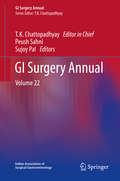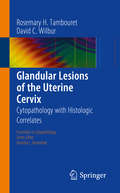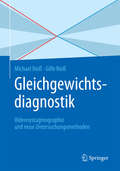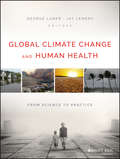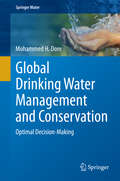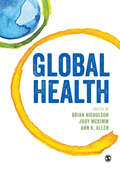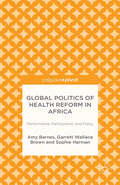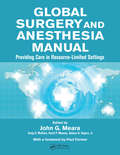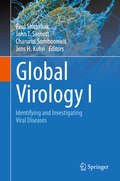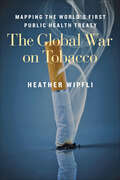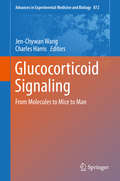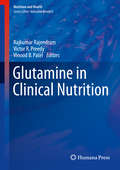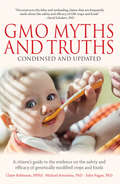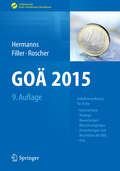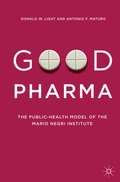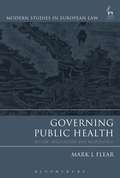- Table View
- List View
GI Surgery Annual: Volume 22 (GI Surgery Annual #22)
by T. K. ChattopadhyayThe twenty-second volume of GI Surgery Annual covers a gamut of topics from oesophageal adenocarcinoma, to motility disorders of the colon and rectum, mesenteric tumours as well as the contemporary technique of ALPPS, acute portal vein thrombosis and small for size syndrome in live donor liver transplant. The chapter on advances in gastrointestinal surgery as every year reviews the important new information in the field in an easy to understand manner.
The Girl From Cobb Street (Mira Ser.)
by Merryn AllinghamShe longed for a family of her own… Growing up in an orphanage on East London’s Cobb Street, Daisy Driscoll never felt the warm heart of home. Forging her own way in the world, determined Daisy struggles to make ends meet as the country finds itself on the brink of the Second World War.
Girl in Glass: Dispatches from the Edge of Life
by Deanna FeiWinner of 2016 Books for a Better Life AwardA Washington Post Book Club SelectionA Public Books Favorite Book of 2015When her daughter was born nearly four months premature, Deanna Fei confronted a shattering question: Had she delivered a child or lost one? Over months in the hospital, as she held the hand of a tiny baby fighting for her life inside a glass box, she came to grips with parenthood at its most elemental. Then, a year after she brought her daughter home, the CEO of her husband's company publicly blamed the medical bills of the beautiful, now-thriving little girl for a cut in employee benefits and attached a price tag to her life, setting off a national firestorm. Girl in Glass is the riveting story of one child's harrowing journey and a mother's impassioned defense of human worth against corporate disregard. With luminous prose and an unflinching eye, Fei explores what it means to save a life: from the front lines of a neonatal intensive care unit to the perils of the American health-care system; from decades of medical innovation to the question of how we care for our most vulnerable; and finally, to the potent force of a child's will to live. Above all, Girl in Glass is a testament to how love takes hold when a new life defies all expectations.
The Girl with Nine Wigs: A Memoir
by Charlotte Caroline Jongejan Sophie van der StapA fun-loving student, Sophie is 21 when she is diagnosed with a rare, aggressive form of cancer. As she faces the challenges of chemotherapy, wigs become a crucial part of her self-expression. With refreshing honesty and a keen eye for the absurd, The Girl With Nine Wigs will make you smile when you least expect it.
Glandular Lesions of the Uterine Cervix: Cytopathology with Histologic Correlates (Essentials in Cytopathology #19)
by Rosemary H. Tambouret David C. WilburThis volume provides a compact, concise and up-to-date resource for pathologists and clinicians who are involved in women’s health. The book summarizes the incidence, epidemiology and risk factors for cervical adenocarcinoma, while reviewing the normal histology of the cervix and glandular lesions of the cervix. The cytological appearance of glandular lesions of the cervix and their mimics is amply illustrated and discussed. Management of glandular lesions is also outlined. Written by authorities in the field, Glandular Lesions of the Uterine Cervix: Cytopathology with Histologic Correlates is of great value to cytopathologists, surgical pathologists, gynecologic oncologists and surgeons.
Gleichgewichtsdiagnostik: Videonystagmographie und neue Untersuchungsmethoden
by Michael Reiß Gilfe ReißDieses Buch vermittelt die Grundlagen der Diagnostik von Gleichgewichtsstörungen unter besonderer Berücksichtigung der thermischen Videonystagmographie. Es werden zunächst die anatomischen und physiologischen Grundlagen des Vestibularsystems sowie die Anamnese und klinischen Untersuchungen und anschließend die apparativen diagnostischen Möglichkeiten zusammengefasst. Die Darstellung des Vorgehens bei der Diagnostik der einzelnen Krankheitsbilder ist sehr praxisnah gehalten. Das Buch beseitigt viele Unsicherheiten in der Diagnose der zugrundeliegenden Ursachen von Gleichgewichtsstörungen, die es nach wie vor gibt. Für HNO-Ärzte, Hausärzte und Neurologen in Klinik und Praxis.
Global Climate Change and Human Health: From Science to Practice
by George Luber Jay LemeryLearn the foundations of climate science and human health Global Climate Change and Human Health examines the environmental crisis from a public health and clinical health perspective, giving students and clinicians the information they need to prepare for the future of health care. Edited by George Luber, associate director for climate change at the Centers for Disease Control and Prevention, and Jay Lemery, associate professor at the University of Colorado School of Medicine and section chief of Wilderness and Environmental Medicine in the Department of Emergency Medicine, and including chapters written by luminaries in the field, this landmark book provides a comprehensive introduction to climate change and health. Students will learn about climate changes direct effect on health, including extreme weather events, altered and degraded ecosystems, and threats to human security and welfare. Discussions on mitigation and adaptation strategies, including disease surveillance, communications, and greening health care, as well as a primer on the core concepts of climate change science are presented. Each chapter has a specific section on the clinical correlations of the impact of climate change on health. Informative illustrations depict increasing aeroallergens, shifting vector habitats, emergent risks, and more. Visual teaching materials broken down by chapter (including PowerPoint lecture slides) are available for instructors. This book shows how human health will be —and already has been — affected and how health care practitioners need to start preparing. Understand the science behind climate change and climate variability Learn how the availability of food and clean water will affect public health Consider the diseases that will surge as vector populations swell Discover mitigation strategies targeted toward the health care community Understanding how climate change affects human rights and how international institutions are responding Increased temperatures bring algal blooms that threaten clean water. Degraded air quality brings allergies, asthma, and respiratory diseases. Ground pollutants lower the nutritional value of food crops. It's clear that climate change is very much a public health concern, and Global Climate Change and Human Health helps those preparing to be on the front lines of health care.
Global Climate Change and Human Health: From Science to Practice
by George Luber Jay LemeryLearn the foundations of climate science and human health Global Climate Change and Human Health examines the environmental crisis from a public health and clinical health perspective, giving students and clinicians the information they need to prepare for the future of health care. Edited by George Luber, associate director for climate change at the Centers for Disease Control and Prevention, and Jay Lemery, associate professor at the University of Colorado School of Medicine and section chief of Wilderness and Environmental Medicine in the Department of Emergency Medicine, and including chapters written by luminaries in the field, this landmark book provides a comprehensive introduction to climate change and health. Students will learn about climate changes direct effect on health, including extreme weather events, altered and degraded ecosystems, and threats to human security and welfare. Discussions on mitigation and adaptation strategies, including disease surveillance, communications, and greening health care, as well as a primer on the core concepts of climate change science are presented. Each chapter has a specific section on the clinical correlations of the impact of climate change on health. Informative illustrations depict increasing aeroallergens, shifting vector habitats, emergent risks, and more. Visual teaching materials broken down by chapter (including PowerPoint lecture slides) are available for instructors. This book shows how human health will be —and already has been — affected and how health care practitioners need to start preparing. Understand the science behind climate change and climate variability Learn how the availability of food and clean water will affect public health Consider the diseases that will surge as vector populations swell Discover mitigation strategies targeted toward the health care community Understanding how climate change affects human rights and how international institutions are responding Increased temperatures bring algal blooms that threaten clean water. Degraded air quality brings allergies, asthma, and respiratory diseases. Ground pollutants lower the nutritional value of food crops. It's clear that climate change is very much a public health concern, and Global Climate Change and Human Health helps those preparing to be on the front lines of health care.
Global Drinking Water Management and Conservation: Optimal Decision-Making (Springer Water)
by Mohammed H. DoreThis book discusses different drinking water treatment technologies and what contaminants each treatment method can remove, and at what costs. The production of drinking water requires adequate management. This book attempts to fill the existing knowlegde gap about (a) water treatment technologies and their costs, (b) risk assessment methods, (c) adverse health effects of chemical contaminants, (d) management protocols, and varying regulatory practices in different jurisdictions, and what successes are possible even with small financial outlays. Addressing water consulting engineers, politicians, water managers, ecosystem and environmental activists, and water policy researchers, and being clearly structured through a division in four parts, this book considers theoretical aspects, technologies, chemical contaminants and their possible elimination, and illustrates all aspects in selected international case studies.Source-water protection, water treatment technology, and the water distribution network are critically reviewed and discussed. The book suggests improvements for the management of risks and financial viability of the treatment infrastructure, as well as ways toward an optimal management of the distribution network through the risk-based management of all infrastructure assets.
Global Health
by Brian D Nicholson Professor Judy Mckimm Ann AllenThe concept of global health has moved on from focusing on the problems of the developing world to encompass health problems with global impact. Global health issues impact daily on local healthcare delivery and professional practice. This illuminating guide for healthcare students and practitioners introduces the major themes, challenges and debates relevant to global health that will equip the reader with the knowledge and skills required to thrive in this multi-faceted area of practice. Key features Puts global health in context considering key issues including health inequalities, human health and the global environment and climate change. Ideal reading for international electives, voluntary work, and further qualifications in global health. Contains insights from leading experts in the field. Relevant to those working in a culturally diverse context whether domestic or international.
Global Health (PDF)
by Brian D Nicholson Professor Judy Mckimm Ann AllenThe concept of global health has moved on from focusing on the problems of the developing world to encompass health problems with global impact. Global health issues impact daily on local healthcare delivery and professional practice. This illuminating guide for healthcare students and practitioners introduces the major themes, challenges and debates relevant to global health that will equip the reader with the knowledge and skills required to thrive in this multi-faceted area of practice. Key features Puts global health in context considering key issues including health inequalities, human health and the global environment and climate change. Ideal reading for international electives, voluntary work, and further qualifications in global health. Contains insights from leading experts in the field. Relevant to those working in a culturally diverse context whether domestic or international.
Global Politics of Health Reform in Africa: Performance, Participation, and Policy
by Amy Barnes G. Brown S. HarmanDrawing on qualitative research with African actors and global health institutions, the authors explore the politics of how performance funding modalities and participation are used to shape health reform in African countries as well as the role of African actors, global policy elites and international donors within these processes.
Global Surgery and Anesthesia Manual: Providing Care in Resource-limited Settings
by Meara Dmd, Meara Dmd McClain Mph, McClain Mph Rogers Jr. Mooney Mph, Mooney MphHighly Commended, BMA Medical Book Awards 2015In 2008, Paul Farmer and Jim Yong Kim described global surgery as the "neglected stepchild" of healthcare, and now leaders from around the world are working to redefine it as a human right through the Lancet Commission on Global Surgery. In order to help advance global surgery and anesthesia as a public
Global Virology I - Identifying and Investigating Viral Diseases
by Paul Shapshak John T. Sinnott Charurut Somboonwit Jens H. KuhnThis book provides trajectories and illustrations of viruses that have catapulted into the global arena (linked to humans, animals, and vectors) due to human behaviors in recent years, as well as viruses that have already shown expansion among humans, animals, and vectors just a few decades ago. Topics in the current book include: vaccinesenvironmental impactemerging virus transmissionFilovirus (Ebola)hemorrhagic feversflavivirusesDengue evasionpapillomavirusesHepatitis CNipah virusgiant viruseshantavirusesbunyavirusesencephalitidesWest Nile virusZika virusXMRVhenipaviruseshuman respiratory syncytial virusinfluenza A virusseveral aspects of HIV-1
The Global War on Tobacco: Mapping the World's First Public Health Treaty
by Heather WipfliThe tobacco industry has capitalized on numerous elements of globalizationâ€�including trade liberalization, foreign direct investment, and global communicationsâ€�to expand into countries where effective tobacco control programs are not in place. As a consequence, tobacco is currently the leading cause of preventable death in the world. Each year, it kills more people than HIV, malaria, and tuberculosis combined. Amid evidence of an emerging pandemic, a committed group of public health professionals and institutions sought in the mid-1990s to challenge the tobacco industry’s expansion by negotiating a binding international law under the auspices of the World Health Organization. The WHO Framework Convention on Tobacco Control (FCTC)â€�the first collective global response to the causation of avoidable chronic diseaseâ€�was one of the most quickly ratified treaties in United Nations history. In The Global War on Tobacco, Heather Wipfli tells the engaging story of the FCTC, from its start as an unlikely civil society proposal to its enactment in 178 countries as of June 2014. Wipfli also reveals how globalization offers anti-tobacco advocates significant cooperative opportunities to share knowledge and address cross-border public health problems.The bookâ€�the first to delve deeply into the origin and development of the FCTCâ€�seeks to advance understanding of how non-state actors, transnational networks, and international institutionalization can impact global governance for health. Case studies from a variety of diverse high-, middle-, and low-income countries provide real-world examples of the success or failure of tobacco control. Aimed at public health professionals and students, The Global War on Tobacco is a fascinating look at how international relations is changing to respond to the modern global marketplace and protect human health.
Glucocorticoid Signaling: From Molecules to Mice to Man (Advances in Experimental Medicine and Biology #872)
by Jen-Chywan Wang Charles HarrisThis timely volume provides a comprehensive overview of glucocorticoids and their role in regulating many aspects of physiology and their use in the treatment of disease. The book is broken into four sections that begin by giving a general introduction to glucocorticoids and a brief history of the field. The second section will discuss the effects of glucocorticoids on metabolism, while the third section will cover the effects of glucocorticoids on key tissues. The final section will discuss general topics, such as animal models in glucocorticoid research and clinical implications of glucocorticoid research. Featuring chapters from leaders in the field, this volume will be of interest to both researchers and clinicians.
Glutamine in Clinical Nutrition (Nutrition and Health)
by Rajkumar Rajendram Victor R. Preedy Vinood B. PatelGlutamine is the most abundant amino acid and is a major contributor to whole body nitrogen metabolism and is considered to be “conditionally essential.” Glutamine in Health and Disease presents the application of current nutritional knowledge by physicians and dietitians and incorporates emerging fields of science and important discoveries. Section 1 covers glutamine structure and function, glutamine synthetase, glutamine binding protein, glutamine transport, glutamine-rich activation domains and transcription, glutamine transaminase and cell biochemistry. Section 2 covers glucose-independent glutamine metabolism, intestinal barrier function, thyroid-stimulating hormone, glutamine resonances, focal ischemia, plasma glutamine, metabolic stress, cancer and absorption. Section 3 covers dipeptide-bound glutamine, DNA protection, oxidative stress, NF-KB, the inflammatory response, the lung, kidney, GI tract and liver, autophagy, ethanol and diabetes. Finally, Section 4 covers the use of glutamine in preoperative states, enteral and parenteral nutrition, pulmonary infections, cancer, hypoxic injury, arginyl-glutamine, paediatrics, pancreatic surgery, the elderly, gastric emptying gastric bypass and use glutamine cocktails. Written by authors of international and national standing, leaders in the field and trendsetters, Glutamine in Health and Disease is essential reading for nutritionists and dietitians, public health scientists, physicians, epidemiologists, policy makers, and health care professionals of various disciplines.
GMO Myths and Truths: A Citizen’s Guide to the Evidence on the Safety and Efficacy of Genetically Modified Crops and Foods (3rd Edition)
by Claire Robinson John Fagan Michael AntoniouIt is often claimed that the case against genetically modified (GM) crops and foods is based on emotion, not science, and that to oppose GM crop and food technology is to be anti-science. It is also claimed that GM crops offer higher yields and better nutrition, that they are safe for health and the environment, that they reduce agrochemical use, and that they are needed to feed the world’s growing population. This book, co-authored by two genetic engineers and a writer/researcher, exposes these claims as false, using scientific and other documented evidence. GMO Myths and Truths summarizes the facts on the safety and efficacy of genetically modified (GM) crops and foods in terms that are accessible to the non-scientist but still relevant to scientists, policymakers and educators. The evidence presented points to many hazards, risks, and limitations of genetic engineering technology. These include harms found in animal feeding and ecological studies, which in turn indicate risks to health and the environment posed by GM crops and foods. The layout of the book enables those readers with limited time to read the chapter summaries, while providing more detail and full references for those who require them. At 164 pages of paperback size, this new condensed version is shorter and more accessible than the authors’ 330-page report by the same name, which has been downloaded over half a million times. The book shows that conventional breeding continues to outstrip GM in developing crops that deliver high yields, better nutrition, and tolerance to extreme weather conditions and poor soils. In agreement with over 400 international experts who co-authored a UN and World Bank-sponsored report on the future of farming, the authors conclude that modern agroecology, rather than GM, is the best path for feeding the world’s current and future populations in a safe and sustainable way.
GOÄ 2015: Gebührenordnung für Ärzte - Kommentare, Analoge Bewertungen, Abrechnungstipps, Anmerkungen und Beschlüsse der BÄK, IGeL (Erfolgskonzepte Praxis- & Krankenhaus-Management)
by Peter M. Hermanns Gert Filler Bärbel RoscherGute Leistung muss gut bezahlt werdenKommentierung der einzelnen LeistungenAbrechenbarkeitSteigerungssätzeMögliche AusschlüsseAktuelle GerichtsurteilePraktische Abrechnungstipps und -beispiele mitAnalogen Bewertungen gemäß GOÄ §6 (2), Auslegungshinweisen und Beschlüssen, u.a. vonBÄK und des Zentralen Konsultationsausschusses für GebührenordnungsfragenBerufsverbändenPVSBesondere Berücksichtigung vonHinweisen auf IGeL-Leistungen Umsatzsteuerpflicht für ÄrzteAmbulante spezialärztliche Versorgung (ASV) im GKV-Bereich – teilweise z.Zt. Abrechnung nach GOÄAbrechnung gegenüber der BeihilfePLUSHinweis auf die Kommentierung praxisrelevanter Analognummern der PKV zur Gebührenordnung für Ärzte Anwendung und Auslegung der GOÄ-Paragraphen im Krankenhausbereich mit GerichtsurteilenAbrechnung von Spezialbereichen, u.a. Schmerztherapie, SchlafmedizinÄrztliche Leichenschau mit Dokumentation und ICD-KodierungenHinweise und Leistungsübersicht zur Abrechnung nach GOÄ für ZahnärzteAlle Informationen für die erfolgreich optimierte Abrechnung:korrekt, rechtssicher, vollständig.
Goal Setting and Motivation in Therapy: Engaging Children and Parents
by Benita Powrie Marjon Ten Velden Lynne Peters Niina Kolehmainen Amanda Kirby Richard Ryan Sylvia Rodger Rose Gilmore Jenny Ziviani Fiona Graham Mary Muhlenhaupt Bronwyn Hemsley Mary Law Gillian King Jessica Kramer Jennifer Siemon Pam Meredith Monica Cuskelly Judy Jones Leanne Sakzewski Anne Poulsen Cheryl Missiuna Nancy Pollock Margaret Wallen Helene Polatajko Kirsty StewartDrawing together motivational theory, research-based evidence and guidance for best practice, this book presents innovative models for goal-setting and goal pursuit in therapy with children. Setting goals not only allows children, and their families, to engage with the overall therapeutic process, but it also provides an essential motivational element throughout the entire therapeutic process. The editors and contributors give practical advice on empathically collaborating with the child and his or her family, to clearly identify achievable goals that can be wholeheartedly pursued. Key information on Self-Determination Theory (SDT) is accessibly explained, which will aid professional understanding of the relationship between motivation, goal-setting, and strong therapeutic practice. The approaches in this book can be used by a wide range of professionals, including those who specialise in working with children with physical disabilities, learning disabilities, and emotional and behavioural difficulties. The combination of theory, research and practical advice makes this book an essential resource for professionals working therapeutically with children, including occupational therapists, speech and language therapists, physiotherapists, counsellors, psychologists, social workers, arts therapists and psychotherapists.
Goal Setting and Motivation in Therapy: Engaging Children and Parents (PDF)
by Amanda Kirby Anne Poulsen Benita Powrie Bronwyn Hemsley Cheryl Missiuna Fiona Graham Gillian King Helene Polatajko Jennifer Siemon Jenny Ziviani Jessica Kramer Judy Jones Kirsty Stewart Leanne Sakzewski Lynne Peters Margaret Wallen Marjon Ten Velden Mary Law Mary Muhlenhaupt Monica Cuskelly Nancy Pollock Niina Kolehmainen Pam Meredith Richard Ryan Rose Gilmore Sylvia RodgerDrawing together motivational theory, research-based evidence and guidance for best practice, this book presents innovative models for goal-setting and goal pursuit in therapy with children. Setting goals not only allows children, and their families, to engage with the overall therapeutic process, but it also provides an essential motivational element throughout the entire therapeutic process. The editors and contributors give practical advice on empathically collaborating with the child and his or her family, to clearly identify achievable goals that can be wholeheartedly pursued. Key information on Self-Determination Theory (SDT) is accessibly explained, which will aid professional understanding of the relationship between motivation, goal-setting, and strong therapeutic practice. The approaches in this book can be used by a wide range of professionals, including those who specialise in working with children with physical disabilities, learning disabilities, and emotional and behavioural difficulties. The combination of theory, research and practical advice makes this book an essential resource for professionals working therapeutically with children, including occupational therapists, speech and language therapists, physiotherapists, counsellors, psychologists, social workers, arts therapists and psychotherapists.
Good Pharma: The Public-Health Model of the Mario Negri Institute
by Donald W. Light Antonio F. MaturoDrawing on key concepts in sociology and management, this history describes a remarkable institute that has elevated medical research and worked out solutions to the troubling practices of commercial pharmaceutical research. Good Pharma is the answer to Goldacre's Bad Pharma: ethical research without commercial distortions.
Governing Public Health: EU Law, Regulation and Biopolitics
by Mark FlearThis book contributes towards EU studies and the growing discourse on law and public health. It uses the EU's governance of public health as a lens through which to explore questions of legal competence and its development through policy and concrete techniques, processes and practices, risk and security, human rights and bioethics, accountability and legitimacy, democracy and citizenship, and the nature, essence and 'future trajectory' of the European integration project. These issues are explored first by situating the EU's public health strategy within the overarching architecture of governance and subsequently by examining its operationalisation in relation to the key public health problems of cancer, HIV/AIDS and pandemic planning.The book argues that the centrality and valorisation of scientific and technical knowledge and expertise in the EU's risk-based governance means that citizen participation in decision-making is largely marginalised and underdeveloped – and that this must change if public health and the quality, accountability and legitimacy of EU governance and its regulation are to be improved. Subsequently the book goes on to argue that the legitimating discourses of ethics and human rights, and the developing notion of EU (supra-)stewardship responsibility, can help to highlight the normative dimensions of governance and its interventions in public health. These discourses and dimensions provide openings and possibilities for citizens to power 'technologies of participation' and contribute important supplementary knowledge to decision-making.
Governing Public Health: EU Law, Regulation and Biopolitics (Modern Studies In European Law Ser.)
by Mark FlearThis book contributes towards EU studies and the growing discourse on law and public health. It uses the EU's governance of public health as a lens through which to explore questions of legal competence and its development through policy and concrete techniques, processes and practices, risk and security, human rights and bioethics, accountability and legitimacy, democracy and citizenship, and the nature, essence and 'future trajectory' of the European integration project. These issues are explored first by situating the EU's public health strategy within the overarching architecture of governance and subsequently by examining its operationalisation in relation to the key public health problems of cancer, HIV/AIDS and pandemic planning.The book argues that the centrality and valorisation of scientific and technical knowledge and expertise in the EU's risk-based governance means that citizen participation in decision-making is largely marginalised and underdeveloped – and that this must change if public health and the quality, accountability and legitimacy of EU governance and its regulation are to be improved. Subsequently the book goes on to argue that the legitimating discourses of ethics and human rights, and the developing notion of EU (supra-)stewardship responsibility, can help to highlight the normative dimensions of governance and its interventions in public health. These discourses and dimensions provide openings and possibilities for citizens to power 'technologies of participation' and contribute important supplementary knowledge to decision-making.
Gratitude
by Oliver SacksOliver Sacks died in August 2015 at his home in Greenwich Village, surrounded by his close friends and family. He was 82. He spent his final days doing what he loved: playing the piano, swimming, enjoying smoked salmon - and writing. As Dr Sacks looked back over his long, adventurous life his final thoughts were of gratitude. In a series of remarkable, beautifully written and uplifting meditations, in Gratitude Dr Sacks reflects on and gives thanks for a life well lived, and expresses his thoughts on growing old, facing terminal cancer and reaching the end. I cannot pretend I am without fear. But my predominant feeling is one of gratitude. I have loved and been loved; I have been given much and I have given something in return; I have read and travelled and thought and written. I have had an intercourse with the world, the special intercourse of writers and readers. Above all, I have been a sentient being, a thinking animal, on this beautiful planet, and that in itself has been an enormous privilege and adventure.
